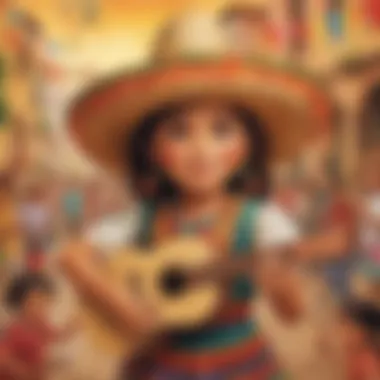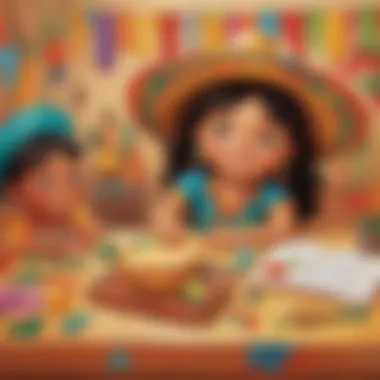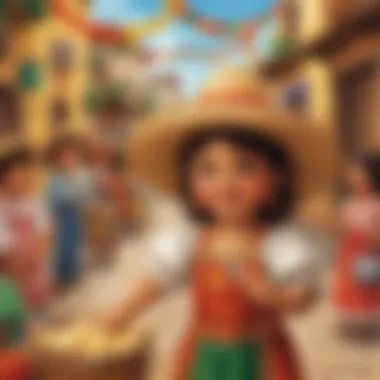Engage Kindergarten Learners with Creative Cinco de Mayo Lesson Plans


Science Fun Facts
In the spirit of Cinco de Mayo, let's uncover some fascinating facts about Mexican culture and history that young learners will find intriguing. Did you know that Cinco de Mayo commemorates the resounding victory of the Mexican army over the French forces at the Battle of Puebla in 1862, rather than Mexico's Independence Day? This celebration is primarily observed in the state of Puebla in Mexico and has gained popularity beyond its origins. It's a fantastic opportunity to introduce children to the significance of this day and the vibrant traditions associated with it.
Discover the Wonders of Mexican Culture
Embark on a journey with kindergarteners to explore the richness of Mexican culture and heritage. Dive into captivating storytelling sessions about Mexican folklore, including tales of brave warriors and colorful celebrations. Engage young minds with interactive lessons on traditional Mexican music and dance forms, fostering an appreciation for the diversity and beauty of this vibrant culture.
Craft Workshop Fiesta
Get hands-on and creative with exciting craft activities that immerse children in the festive spirit of Cinco de Mayo. From designing their own mini piñatas to crafting papel picado banners, these fun projects encourage artistic expression and cultural exploration. With a focus on using bright colors and traditional patterns, these crafts not only stimulate creativity but also enhance fine motor skills.
Cultural Cuisine Adventures
Introduce little chefs to the flavors of Mexico through simple and delicious recipes that are perfect for tiny taste buds. From making refreshing aguas frescas to assembling flavorful tacos with colorful toppings, cooking sessions provide a sensory exploration of Mexican cuisine. Encourage children to taste, smell, and touch various ingredients, promoting culinary curiosity and cultural appreciation.
Celebratory Dance Party
End the Cinco de Mayo festivities with a lively dance party that energizes young participants and promotes physical activity. Teach basic steps of traditional folk dances like La Raspa or La Cucaracha, adding a playful element to the learning experience. By combining music, movement, and cultural traditions, children not only enjoy the celebration but also develop coordination and rhythm skills.
Introduction
Cinco de Mayo is a significant cultural celebration that offers a valuable learning opportunity for kindergarten students. In this article, we explore how innovative lesson plans can immerse young learners in Mexican heritage and traditions, fostering an appreciation for diversity and history. By incorporating engaging activities and hands-on experiences, educators can create a dynamic learning environment that captivates young minds and encourages cultural exploration.
Understanding Cinco de Mayo
Cinco de Mayo holds immense significance as a commemoration of the Mexican victory over France in the Battle of Puebla. This historical event symbolizes bravery, resilience, and national pride, making it a compelling choice for educational exploration. By understanding the importance of Cinco de Mayo, children can grasp the essence of victory against adversity and the value of cultural heritage. While the celebration is not widely observed in Mexico outside of Puebla, it has evolved into a vibrant cultural festival in the United States, showcasing the enduring spirit of the Mexican people.
Significance of Cinco de Mayo
The significance of Cinco de Mayo lies in its representation of Mexican unity and triumph in the face of colonial opposition. This event highlights the courage and determination of the Mexican army, instilling lessons of perseverance and national pride. For kindergarten lesson plans, emphasizing the significance of Cinco de Mayo can instill values of resilience and cultural appreciation in young learners, fostering a sense of community and respect for diversity.
Historical Background


Exploring the historical background of Cinco de Mayo provides insight into the context of this celebrated event. By delving into the origins of the Battle of Puebla and its historical implications, children can develop a deeper understanding of the cultural significance behind the holiday. Learning about the challenges faced by the Mexican forces and their ultimate triumph offers valuable lessons on courage, teamwork, and the importance of preserving cultural identity.
Importance of Cultural Education
Cultural education plays a vital role in shaping well-rounded individuals with a global perspective. Introducing kindergarten students to diverse cultures, such as Mexican heritage during Cinco de Mayo, cultivates awareness, empathy, and respect for cultural differences. By integrating cultural education into lesson plans, educators can nurture inclusive attitudes and broaden students' worldview, laying a strong foundation for lifelong learning and appreciation of diversity.
Lesson Plans
When it comes to developing lesson plans for young learners, especially kindergarteners, incorporating innovative and engaging activities is essential. These lesson plans serve as a foundation for introducing students to the rich cultural tapestry of Cinco de Mayo. By integrating hands-on experiences with educational content, children are not only entertained but also exposed to different facets of Mexican heritage and traditions. Such lesson plans aim to instill curiosity, appreciation, and respect for diverse cultures from a young age. Attention to detail, age-appropriate content, and interactive elements are key considerations for creating comprehensive and effective lesson plans.
Cultural Exploration
Learning about Mexican Culture
Introducing kindergarten students to Mexican culture opens a world of unique traditions, history, and values. Exploring aspects such as traditional Mexican clothing, holidays, and folklore helps broaden young minds and nurture cultural awareness. By immersing children in Mexican customs, they develop a deeper understanding and appreciation for diversity. The inclusion of Mexican culture in lesson plans sparks interest, encourages inclusivity, and fosters a sense of global interconnectedness, making it a valuable component in the education of young learners.
Traditional Mexican Foods
Traditional Mexican cuisine offers a delicious gateway to understanding the culture and heritage of Mexico. From tacos to tamales, each dish carries a history and significance that adds depth to the learning experience. By exploring Mexican flavors and food preparation methods, children not only broaden their palate but also gain insight into the social and historical contexts of these culinary traditions. Incorporating traditional Mexican foods into lesson plans provides a sensory-rich way to connect with a different culture, making learning engaging and memorable.
Music and Dance
Music and dance are vibrant expressions of Mexican culture, captivating audiences with rhythmic beats and colorful movements. For kindergarteners, music and dance activities offer a fun and interactive way to experience Mexican traditions firsthand. Learning simple folk dances or listening to traditional Mexican music exposes children to new sounds, rhythms, and movements, igniting their creativity and imagination. The incorporation of music and dance in lesson plans promotes physical activity, cultural appreciation, and social interaction, enhancing the overall educational experience.
Craft Activities
Pinata Making
Creating piñatas introduces children to a popular Mexican festive tradition, combining artistry and excitement. The process of making a piñata involves teamwork, creativity, and patience, fostering essential skills while encouraging imaginative expression. Engaging in piñata making allows children to explore different materials, shapes, and colors, promoting tactile learning and sensory development. Additionally, the anticipation of breaking the piñata adds an element of suspense and joy to the activity, making it a memorable and thrilling experience for young learners.
Mexican Flag Crafts
Crafting Mexican flag-themed projects provides an opportunity for children to learn about national symbols and colors. Through flag-making activities, students gain an understanding of the significance of flags in representing identity and unity. By incorporating the colors and symbols of the Mexican flag into creative projects, children not only exercise their motor skills but also deepen their cultural knowledge. Mexican flag crafts stimulate visual creativity and cultural appreciation, encouraging students to explore symbolism and patriotism in a hands-on way.
Sombrero Decorations


Decorating traditional Mexican sombreros offers a fun and interactive way for children to engage with cultural attire. By embellishing sombreros with colorful patterns, shapes, and designs, students express their creativity while learning about Mexican fashion traditions. Crafting sombrero decorations encourages attention to detail, fine motor skills, and spatial awareness, enhancing artistic abilities and cultural sensitivity. The hands-on nature of sombrero decorating allows children to personalize their creations, fostering a sense of ownership and pride in their cultural exploration.
Language and Vocabulary
Basic Spanish Phrases
Introducing basic Spanish phrases into lesson plans familiarizes children with a new language and broadens their linguistic repertoire. Learning simple greetings, numbers, and common expressions in Spanish provides a gateway to multicultural communication. By incorporating basic Spanish phrases, students develop an ear for foreign languages, expanding their cultural horizon and language skills simultaneously. Exposure to new languages at a young age enhances cognitive development, encourages curiosity, and promotes inclusivity within diverse linguistic communities.
Learning Colors in Spanish
Exploring colors in Spanish offers an engaging way for children to connect language learning with visual comprehension. Associating colors with their Spanish names not only reinforces vocabulary acquisition but also encourages cross-cultural comparison and expression. By identifying and naming colors in Spanish, students sharpen their observational skills, memory retention, and cognitive association abilities. Including color-related activities in lesson plans stimulates creativity, language proficiency, and cultural appreciation, fostering a holistic approach to early language learning.
History and Heroes
Exploring Mexican History
Delving into Mexican history exposes children to significant events, traditions, and cultural milestones that shape the nation's identity. By exploring historical narratives, students develop a sense of continuity, change, and historical empathy. Understanding Mexican history provides context for contemporary issues, fostering critical thinking and perspective-taking skills. Including historical explorations in lesson plans broadens students' awareness of the world and cultivates a sense of respect for the past, present, and future.
Famous Mexican Figures
Introducing famous Mexican figures to young learners showcases inspirational individuals who have made an impact on Mexican society and beyond. From artists to leaders, these figures represent diverse fields and accomplishments, serving as role models for students. Learning about famous Mexican figures instills values such as resilience, creativity, and cultural pride in children, inspiring them to explore their own potential and aspirations. By highlighting the achievements and contributions of these individuals, lesson plans connect historical narratives with personal narratives, fostering a sense of admiration and curiosity among students.
Interactive Learning
Interactive learning plays a pivotal role in the educational journey of kindergarten students, especially when delving into the vibrant tapestry of Cinco de Mayo. By incorporating interactive elements, children are not only engaged but also immersed in the rich cultural experience that this holiday embodies. Through games, quizzes, and role-playing activities, young learners can actively participate in understanding the significance of Cinco de Mayo beyond just facts and figures. Interactive learning fosters curiosity, critical thinking, and cultural appreciation, all essential skills for growing minds.
Games and Quizzes
Cultural Trivia
Cultural trivia serves as a cornerstone in elucidating the depths of Mexican heritage and traditions. By incorporating fun and informative trivia questions related to Cinco de Mayo, children can grasp the essence of this celebration while expanding their knowledge base. The key characteristic of cultural trivia is its ability to spark curiosity and promote learning through engaging questions and answers. It serves as a beneficial tool in this article by providing an interactive platform for children to actively participate in discovering the significance of Cinco de Mayo. The unique feature of cultural trivia lies in its ability to create a playful learning environment while instilling valuable cultural insights.
Memory Match Games


Memory match games offer a dynamic approach to enhancing memory retention and cognitive skills in young learners. By creating Cinco de Mayo-themed memory games, children can strengthen their recollection abilities while immersing themselves in the festive spirit of the holiday. The key characteristic of memory match games is their ability to combine entertainment with education, making learning enjoyable and effective. These games are a popular choice for this article as they provide a hands-on way for children to internalize important cultural elements related to Cinco de Mayo. The unique feature of memory match games is their capacity to improve concentration and cognitive agility in a fun and interactive manner.
Role-Playing
Role-playing activities offer a compelling means for kindergarten students to embody the essence of Cinco de Mayo and its historical significance. By engaging in celebratory enactments and historical reenactments, children can forge a deeper connection with the culture and values intertwined with this Mexican holiday. Celebrating Cinco de Mayo through role-playing instills a sense of participation and cultural immersion, allowing young learners to appreciate the traditions in a hands-on manner. The unique feature of role-playing lies in its experiential learning approach, fostering empathy and understanding of diverse cultural perspectives.
Celebrating Cinco de Mayo
Celebrating Cinco de Mayo through role-playing activities enables children to partake in the joyous festivities associated with this commemoration. The key characteristic of this activity is its capacity to evoke a sense of excitement and cultural pride among young learners. It is a beneficial choice for this article as it allows children to actively engage with the customs and traditions of Cinco de Mayo in a lively and meaningful way. By celebrating Cinco de Mayo through role-playing, children can cultivate a deeper appreciation for the cultural nuances embedded in this festive occasion.
Acting out Historical Events
Acting out historical events related to Cinco de Mayo offers a unique perspective on the struggles and triumphs that form the backdrop of this holiday. By immersing themselves in dramatizations of key historical moments, children can gain a profound understanding of the challenges faced by the Mexican community and the resilience that defines their heritage. The key characteristic of acting out historical events is its ability to imbue history with life, making it relatable and engaging for young learners. This activity is a valuable choice for this article as it provides a hands-on way for children to connect with the narratives and personalities that shaped the course of Cinco de Mayo's history, fostering empathy and historical consciousness.
Parental Involvement
Home Activities
Cooking Mexican Dishes
Cooking Mexican dishes at home offers a hands-on approach to engage children in the Cinco de Mayo celebrations and educate them about Mexican culture. By involving children in food preparation, parents can teach them about traditional Mexican ingredients, cooking methods, and the significance of various dishes in Mexican cuisine. Cooking Mexican dishes not only exposes children to new flavors and textures but also enhances their fine motor skills, sensory experiences, and cultural awareness. This activity encourages creativity and curiosity in children, instilling a sense of pride and accomplishment as they contribute to the family's Cinco de Mayo festivities.
Decorating for Cinco de Mayo
Decorating for Cinco de Mayo involves transforming the home environment into a vibrant space reflective of Mexican culture and traditions. From creating papel picado decorations to displaying colorful papel flowers, decorating for Cinco de Mayo allows families to immerse themselves in the festive spirit. This activity provides children with opportunities to explore Mexican art, symbols, and colors, promoting their visual literacy and creative expression. Through decorating, families can bond over shared creative endeavors, creating a warm and inviting atmosphere that celebrates the essence of Cinco de Mayo.
Family Traditions
Creating Memories
Creating memories together as a family during Cinco de Mayo reinforces the importance of cherished traditions and shared experiences. Engaging in activities such as preparing traditional dishes, participating in cultural events, or simply spending quality time together fosters a sense of belonging and continuity within the family unit. These shared experiences not only create lasting memories but also strengthen family bonds and cultural heritage, instilling a sense of pride in children about their familial roots and customs.
Engaging in Festivities
Participating in Cinco de Mayo festivities as a family allows for a deeper immersion into Mexican culture and traditions. Whether attending community events, parades, or cultural performances, engaging in festivities creates opportunities for families to connect with their wider community and honor Mexican heritage. This active participation fosters cultural appreciation, intergenerational learning, and social cohesion, reinforcing the significance of Cinco de Mayo beyond a mere historical event. By engaging in festive activities, families can instill a sense of cultural identity and respect in children, nurturing a connection to their heritage.
Conclusion
Moreover, integrating cultural education into early childhood curriculum not only enriches students' knowledge but also promotes inclusivity and appreciation for cultural differences. By actively involving parents and caregivers in these lesson plans, schools can establish a collaborative learning environment that extends beyond the classroom, encouraging family engagement and creating lasting memories for children.
With a focus on interactive learning experiences, meaningful connections to real-world applications, and a strong emphasis on fostering a sense of cultural competence and global awareness, the Cinco de Mayo lesson plans for kindergarten embody the essence of holistic and multicultural education. By embracing and implementing these innovative lesson plans, educators can empower young learners to become culturally literate individuals who appreciate and respect the diverse tapestry of our global society.







